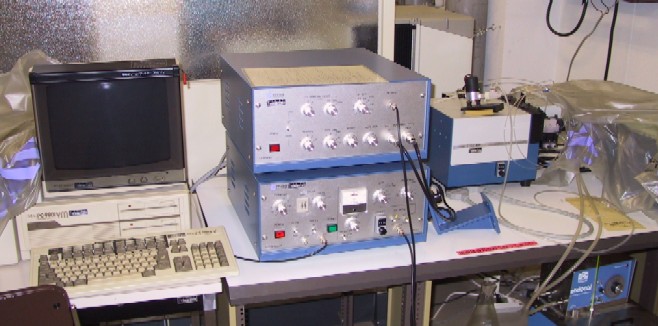
Circular Dichroism Distributor (CD)
Jasco J820P (Room 5)
A chiral molecule is a molecule that cannot be superimposed on its mirror image, where both molecules constitute an optical isomeric pair, and if one has S-configuration, the other has R-configuration. In natural products, only one type of configurations is present in each chiral center and the characteristic function arises from its own spatial structural arrangement. Many such examples are found in amino acids, hormones, enzymes, proteins, nucleic acids, sugars, etc. Therefore, it is very important to determine which optical isomer is present in a biomolecule (i.e., determination of the absolute configuration of the optical isomer). A chiral molecule absorbs left- and light-circularly polarized radiation with different intensities (I L and I R), and such property is called optical circular dichroism (CD). The CD spectrum itself is a record of the difference in intensity (I L - I R) against wavelength and shows a pattern inherent of the absolute configuration present in a biomolecule and hence, can be used to determine the absolute configuration of optical isomers in unknown compounds. A JASCO J-820 CD Polarimeter was installed in the center on March, 2002.
Specifications:
Light source: 450 W Xe arc lamp (water cooled)
Wavelength range: 163-1100nm
Wavelength accuracy: 163-180 nm :+- 0.2nm ; 180-250 nm :+- 0.1 nm ; 250-500 nm: +- 0.3 nm; 500-800nm : +- 0.8nm; 800-1100nm: +- 2 nm
Scan speed: 1-10000 nm/min
CD full scale: +- 10 mdeg / +- 00mdeg / +- 200 mdeg
Input channels: 2 internal plus 2 external signals can be acquired simultaneously
Data processing system: Display and overlay the spectra, data file arithmetic operations, derivatives, peak detection and processing, smoothing,baseline correction, data file conversion (CAMP-DX,ASC format), printing layout etc.
Others: CD and UV spectra can be measured simultaneously.
|

Stop-Flow Spectrophotometer (SF)
Otsuka Electronics RA-401 (Room 5)
Chemical reactions in bio-systems are usually very fast. The stopped-flow technique is used in the study of such fast reactions. In this technique, solutions of the reactants are impelled into a mixing chamber as a piston is withdrawn suddenly to a stop. The composition in the chamber is then monitored, for example, by measuring the change of absorption spectra with time. Another method is the relaxation method: When the chemical reaction system which is initially in an equilibrium state is perturbed, such as by a temperature jump, a sudden change to a higher temperature and the composition relaxes to the new equilibrium, which will give information about the relaxation times. In conjunction with information about the equilibrium constants, we can know the rate constants also.
The center has an Otsuka Electronics RA-401 stopped-flow spectrophotometer. This system is useful for the above-mentioned studies, and can be used also in other research fields, for example, conformational analyses of liquid-crystalline molecules showing cholesteric/smectic C* phases, analyses of various chemical reactions such as acid-base, oxidation-reduction, complex formation, organic, and catalytic processes, etc.
Specifications:
Sample: liquid only
Range of wavelength: 800-200 nm
Range of reaction rate: 0.1 ms to 30 ms, 7 steps
Range of temperature: -20 C to c.a. 95 C
|



